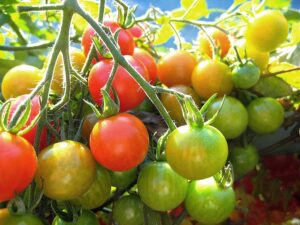By: Rebecca Salerno
Recently I started working for a medical cannabis dispensary in my hometown, I assist in the growing and production of the plant for medicinal use. Now that Cannabis is legal in Massachusetts I have had the opportunity to work in this industry professionally, and am excited to be sharing the knowledge I’ve gained so far on the growth cycle of a cannabis plant. Cannabis, also known as marijuana, is a psychoactive drug used for medical or recreational purposes. The main psychoactive part of cannabis is tetrahydrocannabinol (THC). Cannabidiol (CBD) is a non-psychoactive compound. THC and CBD are both cannabinoids derived from the cannabis plant. Cannabinoids are chemical compounds found in the cannabis plant that interact with receptors in the brain and body to create various effects. There exist hundreds of cannabinoids in the cannabis plant, but THC is most widely known among these due to its abundance and euphoric attributes. While THC is the principal psychoactive component of cannabis and has certain medical uses, CBD stands out because it is both non-intoxicating and displays a broad range of potential medical relief including help with anxiety, inflammation, pain, and seizures. These make CBD an attractive therapeutic compound.

Cannabis plants, like all living things, go through a series of stages as they grow and mature. It’s important for me as a grower to understand the changes a plant undergoes during its life cycle, as each stage of growth requires different care. Different stages call for different amounts of light, nutrients and water. The stages also help us decide when to prune and trim the plants, and overall health as well. The life cycle of cannabis can be broken down into four primary stages from seed to harvest:
- Germination
- Seedling
- Vegetative
- Flowering
The first stage of life for a cannabis plant begins with the seeds. At this point, our cannabis plant is dormant, patiently waiting for water to bring it to life. Between 5-10 days the seed should pop. Once the seed has popped, it’s ready to be placed in its growing medium. The tap root will drive down while the stem of the seedling will grow upward. Two rounded cotyledon leaves will grow out from the stem as the plant unfolds from the protective casing of the seed. These initial leaves are responsible for taking in sunlight needed for the plant to become healthy and stable. As the roots develop, you will begin to see the first iconic fan leaves grow, at which point the cannabis plant can be considered a seedling. When the plant becomes a seedling, you’ll notice it developing more of the traditional cannabis leaves. As a sprout, the seed will initially produce leaves with only one ridged blade. Once new growth develops, the leaves will develop more blades.

A mature cannabis plant will have between 5-7 blades per leaf, but some plants may have more. A healthy seedling should be a vibrant green color. We have to be very careful to not overwater the plant in its seedling stage, its roots are so small, it doesn’t need much water to thrive (reminds me of cacti and other succulents). Its extremely important for us to keep the environment clean and to monitor excess moisture. At this stage, the plant is vulnerable to disease and mold.
The vegetative stage of cannabis is where the plant’s growth truly takes off. At this point, we’ve transplanted the plant into a larger pot, and the roots and foliage are developing rapidly. This is also the time to begin topping or training the plants (we generally use bamboo). Spacing between the nodes should represent the type of cannabis you are growing. Indica plants tend to be short and dense, while sativa plants grow lanky and more open in foliage.
As the plant develops we also have to change our watering style. When it’s young, the plant will need water close to the stalk, but as it grows the roots will also grow outward, so we start watering further away from the stalk so the roots can stretch out and absorb water more efficiently (also helps things stay sturdy).
The flowering stage is the final stage of growth for a cannabis plant. Flowering occurs naturally when the plant receives less than 12 hours of light a day, in our case we grow inside so we just adjust the indoor light cycle. It is in this stage that resinous buds develop (the flower).
Once the buds have reached full maturity, it’s time to harvest.

My plans for the future are to someday own my own cannabis grow operation, and maybe even open up a lounge. I hope with the experience I am having at my work will pay off in the future.


